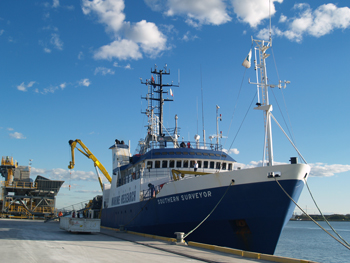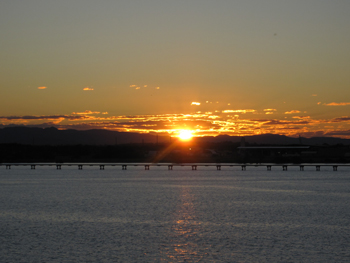15 May 2011, by Taryn Noble and Andrew Bowie

On the Friday the 13th, we left the Port of Brisbane on the Southern Surveyor around 16:30. The Port of Brisbane, situated about 30 km outside the city, is enormous and is home to lots of industrial activities such as oil refineries and coal stores for export. Luckily for us, the wind was not blowing on Friday, but when it does the ship and everyone at the dock gets covered in fine coal dust, from the adjacent coal pile. The science party arrived earlier that day to set up equipment and get settled before leaving. We have a great team of 11 scientists on board, as well as a very friendly and helpful crew. There is a wonderful mixture of people from all over the world, with eight different nationalities including Australian, British, Canadian, French, Irish, New Zealand, South African and Swiss.

We started our voyage with beautiful sunny Queensland weather, with the sun setting as we left the port. Those of us who have never been to sea before, or not very often, were relieved to be heading off in good weather. We set off along the coast of Queensland at 27oS; making our way along the continental shelf in waters of around 80 m depth to 30oS where the GEOTRACES GP13 transect begins. On Saturday morning we woke up to the remarkable sight of the Gold Coast, a mass of tall skyscrapers situated right along the beach; a real contrast from the wide expanse of beaches with a mountainous background, seen along the rest of the coastline. This was also around the time that people were starting to struggle with seasickness, despite the relatively smooth seas. Most people started taking ginger tablets, a natural remedy to help with seasickness, but many had moved on to something stronger by the afternoon!
Before reaching the first station, trial runs also known as a “toolbox” for each of the activities was carried out. This involved testing the CTD and trace metal rosette to ensure that all the equipment was in good working order and each operation was carried out safely. With everything in order we continued on to our first “normal” station at 30o S, 153.5 oE. The first station was successful with seawater collected from both the CTD and trace metal rosette down to the ocean bottom, a depth of about 90 m. The weather was starting to get rough at this stage, which was a good reminder about tying all the equipment down safely.
The science party has been split into two working groups to cover 24 hours. Each person has been assigned a 12-hour shift, either working from midday to midnight, or midnight to midday. It is harder for those of us working the midnight to midday shift, as it takes some time for your body to adjust. By now we have all found our sea legs, which more correctly turns out to be a sea stomach! Food is served three times a day at 07:00, 11:30 and 17:00, but there is always plenty of food in the mess no matter what time of day. The food has been very good and the stewards provide a wide variety of hot food and different salads and fresh fruit and yummy desserts at dinner time.
Our first full day at sea ended with the ship approaching our first open ocean station off the east Australian shelf.

